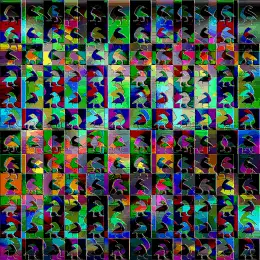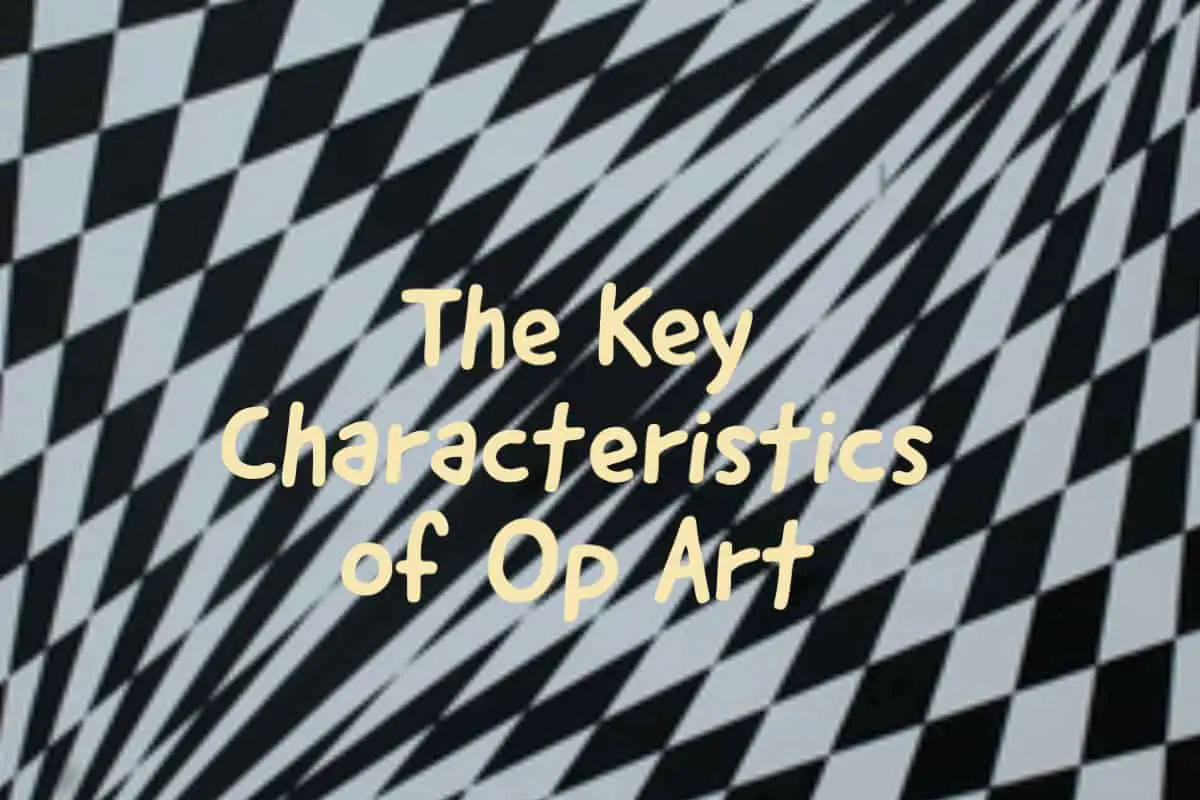Op Art is a type of artwork that most people have seen. Many people may not even realize that Op Art is considered an art movement.
Op Art, also known as Optical art, is a visual art about using optical illusions. The art will give the viewers an impression that the objects are larger, smaller, closer, or further away than they actually are. The viewer of Op Art will have the impression of the art moving, or they may see hidden images, a flashing sensation, or feel the art is vibrating, swelling, or warping.
Table of Contents
- Exploring Op Art: Defining Characteristics of the Optical Art Movement
- How is Op Art Used Today?
- Frequently Asked Questions
- Related Questions
Exploring Op Art: Defining Characteristics of the Optical Art Movement
Op Art, a visual style widely recognized yet often not identified as a distinct art movement, captivates viewers with its mastery of optical illusions. Known formally as Optical Art, this genre plays with visual perception, creating artworks that manipulate our sense of space and depth.
Op Art pieces often give the illusion of motion or hidden imagery, evoking sensations of movement, flashing, or even a pulsating effect. These artworks skillfully distort the viewer’s perception, making objects appear larger, smaller, nearer, or further away than they really are, and sometimes even seem to vibrate, swell, or warp, challenging our visual experiences.
What is Op Art?
Op Art is short for Optical Art. It is a style of visual art that uses optical illusions as to its main technique and focus. The Op Art will give the viewers an impression of the art having movement, hidden images, flashing, vibrating patterns, swelling, or warping.
Time Magazine coined the phrase, Op Art, in 1964 in response to Julian Stanczak’s’ art exhibition. The art exhibition was called Julian Stanczak: Optical Paintings and it took place at the Martha Jackson Gallery in New York City.

Who invented Op Art?
Most people credit the artist Victor Vasarely as inventing or starting the Op Art movement. Victor Vasarely, the Hungarian-French artist, is widely considered the grandfather and leader of the Op Art movement.
Victor Vasarely’s painting of Zebras (1938) comprises curvilinear black and white stripes. The Zebra painting is a great example of how Op Art started before the 1960s or before Time Magazine coined the phrase “Op Art.”
Victor Vasarely was initially studying medicine to become a doctor. Many give credit to his scientific background and training as part of his foundation for Op Art creation.
When Did Op Art Become Popular?
Op Art started to gain popularity in the late 1950s but really focused on becoming a major Op movement in the 1960s and 1970s. The leading artists for the Op Art movement were Victor Vasarely, Bridget Riley, Richard Anuszkiewicz, Larry Poon, and Jeffrey Steele.
The Op Art movement started to gain international at the 1965 exhibition called The Responsive Eye at the Museum of Modern Art in New York City. This exhibition later toured the American cities of St Louis, Seattle, Pasadena, and Baltimore.
This exhibition featured many famous Op Art artists. But more than this, the exhibition focused on art as an illusion of movement and how color helped interact with this illusion.
The exhibition was a huge success for the public, but the art critics were not impressed. Many art critics felt the exhibition was nothing more than an illusion or a way to trick the human eye.
Although the critics were not too impressed with the exhibition, the exhibition’s public success ensured that Op Art stayed around for a while as an art movement.

What are the elements of Op Art?
Op Art’s main elements are about the optical illusion that is seen by the human eye. It is also known as geometrical abstract art. The Op art artists will use optical illusion techniques through systematic and precise manipulation of shapes and color.
The illusion caused by Op Art can either be a perspective of illusion or chromatic tension. The perspective illusion was about using an optical illusion to make an object look farther away, closer, larger, or smaller than it actually is. Chromatic tension is about using chromatic colors to help with the optical illusion.

How is Op Art Used Today?
The gift that Op Art gave us today can be seen in the use of 2D and 3D art today. One of the venues that Op Art has long been used is with the 2D or 3D art known as street art or graffiti.
Many street artists use optical illusion techniques to have certain objects or parts of the art jump out at you from the wall. This is all part of the optical illusion techniques that street artists use.
Op Art is one of the art movements that is truly unique from so many other art movements. This is because Op Art can usually be easily recognized.
Anita Louise Art is dedicated to art education, great artists, and inspiring others to find and create their art. We love art that uplifts and inspires. #ArtToMakeYouSmile! #ArtToMakeYouHappy!
If you are interested in seeing any of my art, you can find out more by clicking here. If you are interested in what inspires me and my paintings, you can discover more by clicking here.
We have a free newsletter and would love you to be part of our community; you can subscribe to the newsletter by clicking here. If you have any questions, I would be happy to talk to you at any time. You can reach me, Anita, by clicking here.
Subscribe to our Anita Louise Art YouTube Channel filled with great videos and information by clicking here.
Join us for our podcast “5 Minutes With Art.” Spend just 5 minutes a week with us to discover and learn about great art and artists. You can find out more about our podcast by clicking here.
Frequently Asked Questions
What is the Arts and Crafts Movement?
The Arts and Crafts Movement was a late 19th-century artistic and design movement that emerged as a reaction against industrialization. It sought to revive traditional craftsmanship and emphasize the importance of individual craftsmanship in the creation of everyday objects.
When did the Arts and Crafts Movement originate?
The movement originated in the United Kingdom in the late 19th century, gaining momentum in the 1880s and 1890s. It later spread to other parts of Europe and North America.
Who were the key figures of the Arts and Crafts Movement?
Prominent figures include William Morris, John Ruskin, and Charles Rennie Mackintosh. William Morris, in particular, played a significant role in promoting the ideals of the movement.
What were the main principles of the Arts and Crafts Movement?
The movement emphasized the importance of craftsmanship, the use of natural materials, and the integration of art into everyday life. It rejected mass production and encouraged the revival of traditional techniques.
How did the Arts and Crafts Movement influence architecture and design?
The movement had a profound impact on architecture and design, promoting the use of traditional craftsmanship, simple forms, and a focus on functional and practical design elements.
What types of materials were commonly used in Arts and Crafts Movement creations?
Craftspeople associated with the movement preferred using natural materials such as wood, metal, glass, and ceramics. Handcrafted techniques like weaving, pottery, and metalworking were highly valued.
Did the Arts and Crafts Movement have a social or political agenda?
Yes, the movement had a social and political dimension. Advocates believed in the dignity of labor and sought to improve the working conditions of artisans. They also criticized the dehumanizing effects of industrialization.
How did the Arts and Crafts Movement impact the decorative arts?
The movement influenced the decorative arts by promoting the creation of aesthetically pleasing and functional objects. This led to the production of finely crafted furniture, textiles, and ceramics.
Did the Arts and Crafts Movement extend beyond Europe?
Yes, the movement had a significant impact on North America, particularly in the United States. American Arts and Crafts artisans, such as Gustav Stickley, embraced the principles of the movement and adapted them to the American c
Related Questions
Who Was Georgia O’Keeffe, The Mother of American Modernism Painting?
Georgia O’Keeffe was a dairy farm girl from Wisconsin who became one of America’s great iconic painters. She received a college education but had to leave college due to her father’s untimely bankruptcy. When she was in school in New York, she met her future husband, the photographer and gallery owner Alfred Stieglitz. She is most well known for her many American Western subject matters and oversized flowers that she painted. She had a home and studio in the US state of New Mexico. You can visit her home in New Mexico and the Georgia O’Keeffe Museum in Santa Fe, New Mexico.
You can discover more by reading our blog Georgia O’Keeffe, The Mother of American Modernism Painting by clicking here.
Why Was Impressionism Art at First Rejected?
During the emergence of impressionism art, fine art oil painting was an essential addition to the interior design of a home, especially for the affluent and the increasing arrival of the middle classes. For these art patrons, only some particular art styles were considered acceptable for them to use for the interior design of their home, and impressionism art did not fit into any of these culturally acceptable fine art categories.
You can learn by reading our blog Why Was Impressionism Art at First Rejected? by clicking here.

